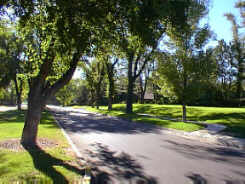" . . . sense of place is not a fine-art extra, it is something which man cannot afford to do without. However happy the family, however pretty the subdivision, unless it is part of a bigger community that can recognize itself as being specific, different (in the same way that you recognize your own children), something is missing. Where ... are you if you live in, say, one of the fearful anonymities around Greater Boston, or on a subdivision ten miles from a Carolina town, five miles in the other direction from a school, two miles from a supermarket? The complete fragmentation of the whole man-made environment in this way is not a liberation of life but an explosion, and it will end in an equivalent fragmentation or disorientation inside the personalities of its inhabitants."
--From The American Landscape: A Critical View, by Ian Nairn, Random House, New York (1965)
 |
Since the 1940s Albuquerque has grown from a small town of 40,000 people to a city of nearly a half million. While it may be easy to identify with a small town, relating to a larger city in its entirety is more difficult.
Sound, color, texture, smell, and human feelings are all associated with the places in our lives - where we work, go to school, live, shop, and play. The natural environment, an area's social life, its history and the cultural background of its residents combine to give each community its individual image and sense of place.
We experience places in terms of the values and expectations we bring to them. Our perception and appreciation of a place changes as we learn more about it and experience it. We shape places through our actions and, in turn, the places we create come to shape our lives.
Albuquerque has been described by some as a "placeless place," but a closer look reveals a collection of diverse and interesting communities. In 1993 and 1994 the city held a series of public workshops asking Albuquerque residents to describe the features that give a special sense of place to their part of Albuquerque. Workshop participants identified the geographic extent of their communities, activity centers, notable landmarks, important street features, and other distinctive characteristics that are familiar and meaningful to the people who live or work there.
Ten distinct Albuquerque communities identified through this process are described in this chapter: Northwest Mesa, Southwest Mesa, South Valley, Central Albuquerque, North Valley, Near Heights, Mid-Heights, East Gateway, Foothills, and North Albuquerque. Also included are brief sections on East Mountain Communities, Kirtland, and Rio Rancho.
Note: We regret that space limitations necessitate omission of other Albuquerque/Bernalillo County communities that also possess strong identities.
(Up to Section II, Back to Central Avenue - Object Lesson, On to Northwest Mesa)